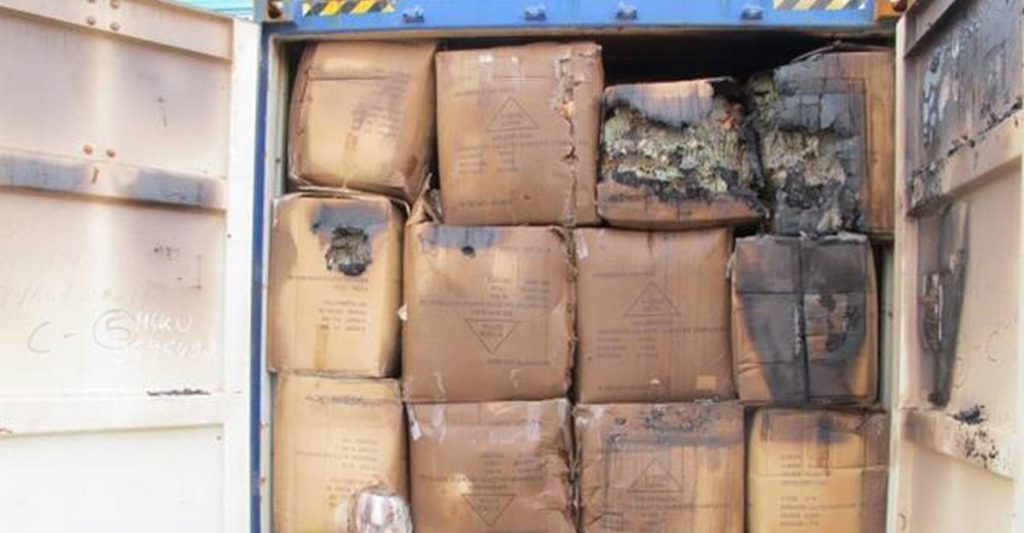Case Studies with Container Desiccants


Case Studies by Climate
| Case Study | Climate | Desiccant Used | Outcome |
|---|---|---|---|
| Electronics in Tropical Areas | High humidity | InterDry Power Desiccant | Prevented corrosion and short-circuits |
| Food in Dry Environments | Low humidity | Clay-based desiccant | Maintained freshness during shipping |
Table of Contents
I. Introduction
Shipping container desiccants play a crucial role in protecting cargo from moisture-related damages, and understanding their effectiveness can be essential for businesses. In this article, we will examine real-world success stories involving the use of InterDry Power Desiccant, Ecobag, and KeepDry, showcasing their effectiveness in various industries.
Common Industries Using Container Desiccants
| Industry | Goods Protected | Moisture Risk |
|---|---|---|
| Electronics | Circuit boards, devices | Corrosion, short-circuits |
| Textiles | Fabrics, clothing | Mold, mildew |
| Food | Packaged goods, dry foods | Spoilage, bacterial growth |
| Pharmaceuticals | Medicines, capsules | Reduced efficacy, contamination |
II. The Importance of Shipping Container Desiccants
Before diving into the case studies, it’s important to understand the role shipping container desiccants play in maintaining the quality and safety of transported goods. These products help to control humidity levels within shipping containers, preventing issues such as mold, corrosion, and other types of moisture damage that can significantly impact cargo quality and value.
III. InterDry Power Desiccant: Real-World Success
A. Case Study 1:
A prominent medical glove exporter faced challenges in protecting their cargo from moisture damage during transit from Southeast Asia to the United States. By strategically placing InterDry Power Desiccant units within the container, moisture levels were effectively controlled, and the gloves remained safe from damage throughout the journey. The exporter experienced a significant reduction in moisture-related issues and losses, ultimately enhancing their reputation for delivering high-quality medical gloves to customers in the demanding healthcare sector.
B. Case Study 2: Rice Exporter
A rice exporter experienced mold and spoilage during international shipments until they turned to InterDry Power Desiccant for better cargo protection. The desiccant helped to maintain an optimal humidity level inside the shipping containers, preventing the growth of mold and ensuring that the rice products arrived at their destination in pristine condition.
C. Case Study 3: Tapioca Maltodextrin Exporter
By implementing the InterDry Power Desiccant solution, the tapioca maltodextrin exporter experienced a significant reduction in moisture-related issues. The Power Desiccant effectively controlled humidity levels within the containers, preventing condensation and subsequent product damage.
D. Case Study 4: Toy Factory
A renowned toy factory faced challenges in protecting their delicate and intricate products from moisture damage during transit from their manufacturing facility in Thailand to various global markets. By carefully positioning InterDry Power Desiccant units within the containers, the toy factory was able to maintain optimal humidity levels, safeguarding their products from potential damage caused by moisture. As a result, the toy factory significantly reduced moisture-related issues and increased customer satisfaction, while maintaining their reputation for delivering high-quality toys worldwide.


IV. Ecobag: Effective Moisture Prevention in Action
A. Case Study 5: Textile Company
A textile company struggled with dampness and mildew in their fabric shipments until they discovered the effectiveness of Ecobag desiccants. By using these desiccants, they were able to protect their textiles from moisture damage, preserving the quality and appearance of the fabrics and reducing customer complaints.
B. Case Study 6: Automotive Parts Supplier
An automotive parts supplier faced rust and corrosion issues with their metal components until they implemented Ecobag desiccants in their shipping process. The container desiccants helped to control humidity within the shipping containers, preventing the formation of rust and corrosion on the metal parts and ensuring their safe arrival at their destination.
C. Case Study 7: A Canned Tuna Exporter
A prominent canned tuna exporter, shipping their products from Southeast Asia to various international destinations, encountered issues with condensation within their containers, which led to damaged packaging and compromised product quality. They turned to Ecobag desiccants to combat this issue and protect their valuable cargo. By strategically placing Ecobag desiccants throughout their containers, the exporter successfully eliminated excess moisture and maintained the desired humidity levels during the entire shipping process. This not only preserved the integrity of the canned tuna packaging but also ensured consistent product quality upon arrival at their destination. The use of Ecobag desiccants proved to be a cost-effective and efficient solution, greatly enhancing their reputation for delivering top-quality canned tuna to their customers around the world.
Types of Container Desiccants
| Desiccant Type | Material | Absorption Capacity | Usage |
|---|---|---|---|
| Silica Gel | Silicon Dioxide | Moderate | Short-term, small containers |
| Calcium Chloride | Calcium-based | High | Long-haul shipping, humid climates |
| Clay | Natural Clay | Low | Short-distance, dry environments |
V. KeepDry: Real-World Examples of Shipping Success
A. Case Study 7: Pharmaceutical Company
A pharmaceutical company needed to maintain strict humidity control during transportation, and KeepDry desiccants provided the solution they were looking for. By using these desiccants in their shipping containers, the company was able to protect their sensitive pharmaceutical products from moisture damage and ensure their safe arrival at their destination.
B. Case Study 8: Electronics Manufacturer
An electronics manufacturer faced issues with moisture damage during the shipment of sensitive components but found a solution with KeepDry container desiccants. By incorporating this product into their shipping process, they significantly reduced instances of damaged components, saving both time and money on replacements and customer returns.
Risks of Not Using Desiccants
| Risk | Impact on Goods |
|---|---|
| Mold Growth | Spoils food, damages fabrics |
| Corrosion | Ruins electronic components |
| Condensation (Container Rain) | Deteriorates packaging, causes rust |
| Product Spoilage | Reduces shelf life and quality |
VII. The Impact of Proper Moisture Control: Real-World Results
These real-world case studies demonstrate the importance of choosing the right shipping container desiccant to ensure cargo protection and shipping success. By selecting the appropriate desiccant for their specific needs and implementing them effectively, businesses in various industries can avoid costly moisture-related damages and maintain the quality of their products during transportation.
VIII. Conclusion:
Protecting Your Cargo with the Right Desiccant Selecting the right shipping container desiccant is essential for maintaining the quality and value of your cargo during transportation. By learning from these real-world success stories and understanding the effectiveness of InterDry Power Desiccant, Ecobag, and KeepDry, you can make an informed decision to protect your goods from moisture damage and achieve shipping success.
IX. Frequently Asked Questions (FAQ)
What factors should I consider when choosing a shipping container desiccant?
When choosing a shipping container desiccant, consider factors such as the type of cargo you are shipping, the climate conditions along the shipping route, and the duration of the transportation process. Different desiccants may be more effective for specific types of cargo and shipping conditions, so it’s important to select the right one for your needs.
How do I determine the appropriate amount of desiccant to use?
The appropriate amount of desiccant to use depends on factors such as the size of the shipping container, the type of cargo, and the expected humidity levels during transportation. You can consult with desiccant manufacturers or experts in the field to help determine the optimal amount for your specific situation.
How often should I replace the desiccants in my shipping container?
The frequency of desiccant replacement depends on factors such as the duration of the shipping process and the humidity levels encountered during transportation. It’s essential to monitor the condition of the desiccants regularly and replace them as needed to maintain optimal humidity control within the container.
Can I reuse shipping container desiccants?
Some types of desiccants, such as silica gel, can be regenerated and reused by removing the absorbed moisture through a heating process. However, this may not be practical or cost-effective for all situations. Always consult with the desiccant manufacturer to determine the best practices for reuse.
Are shipping container desiccants safe for use with food products?
Most shipping container desiccants, including InterDry Power Desiccant, Ecobag, and KeepDry, are safe for use with food products as they are designed to control humidity without coming into direct contact with the cargo. However, it’s important to check the specific desiccant’s safety information and ensure that it’s suitable for use with food products.
What is a container desiccant?
A container desiccant is a moisture-absorbing material placed in shipping containers to protect goods from moisture damage during transit.
How do container desiccants work?
They absorb excess moisture in the air, preventing condensation and the damage that humidity can cause to shipped goods.
What industries benefit from using container desiccants?
Industries like electronics, textiles, food, and pharmaceuticals benefit from using desiccants to protect moisture-sensitive goods.
Why is moisture control important in shipping?
Moisture control prevents product damage like mold growth, corrosion, and packaging deterioration during long shipping journeys.
How does climate affect container desiccant performance?
In humid climates, desiccants play a crucial role in absorbing higher levels of moisture, ensuring product safety.
Can container desiccants be reused?
No, once desiccants absorb their full moisture capacity, they should be replaced.
What are some case study examples of desiccants preventing damage?
Case studies have shown desiccants preventing corrosion in electronics and avoiding spoilage in perishable goods like food.
What types of goods are most at risk during shipping without desiccants?
Goods such as electronics, fabrics, leather, and food products are most susceptible to moisture damage.
How long do container desiccants last?
Depending on the climate and conditions, desiccants can last for several weeks to months, providing long-term moisture control.
Can container desiccants prevent mold growth?
Yes, desiccants absorb excess moisture that would otherwise foster mold growth, protecting the cargo.
How many desiccants are needed for a shipping container?
The number of desiccants required depends on the size of the container, the duration of transit, and the humidity levels.
What are the environmental impacts of container desiccants?
Many desiccants are eco-friendly and non-toxic, posing no harm to the environment after disposal.
How are desiccants packaged for shipping?
Desiccants are typically packed in sealed sachets or bags that can be easily distributed throughout the shipping container.
What is container rain, and how do desiccants prevent it?
Container rain refers to condensation forming inside containers due to temperature fluctuations, and desiccants absorb the moisture to prevent this.
Can container desiccants be used in all climates?
Yes, container desiccants are effective in all climates, though they are particularly vital in humid or tropical regions.
A Container Desiccant Study on Temperature and Relative Humidity
Comparing Different Types of Shipping Container Desiccants
https://www.yumpu.com/en/document/view/10676010/temperature-humidity-in-ocean-containers
ขอบคุณที่ใช้เวลาอ่านบทความของเราเกี่ยวกับการป้องกันความชื้น ทางเราหวังว่าท่านจะได้รับข้อมูลที่มีคุณค่าและเป็นประโยชน์ ทางเรายินดีให้บริการการปรึกษาฟรีเพื่อพูดคุยเกี่ยวกับความต้องการของท่านและให้คำแนะนำเกี่ยวกับวิธีการป้องกันความชื้นที่กำหนดเฉพาะสำหรับคุณ โปรดติดต่อเราที่ 0858124188 เพื่อนัดหมายการปรึกษาหรือเยี่ยมชมร้านค้าของเราเพื่อค้นหาผลิตภัณฑ์ที่ช่วยป้องกันสินค้าของคุณจากความเสียหายจากความชื้น ทางเราหวังว่าจะได้รับข่าวสารจากท่านเร็วๆนี้
